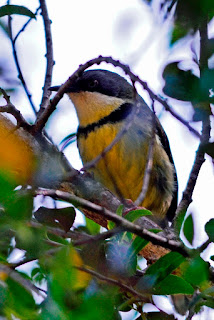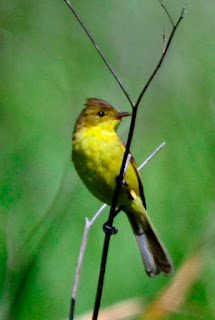Attendees: Stan & Val Culley, Danie & Bella du Toit, Bob & Hazel van Rooyen
Species: 50 Text & Photos: Hazel van Rooyen
Our first outing of the year was quite ambitious – Ingeli Forest, checking for Cape Parrots and Blue Swallows and the Summer CWAC but six of us gave it a good shot. After a long drive in very misty conditions we met up at Ingeli Forest Lodge (now called Anew Hotel Ingeli Forest & Spa). Whilst greeting, we saw Long-crested Eagle, Cape Robin-Chat, Amethyst Sunbird, Jackal Buzzard, Olive Pigeon & Grey Crowned Cranes. The weather suddenly changed, the sun evaporated the mist and we had blue blue skies for the rest of the day - gorgeous!
We proceeded into the forest to check out our favourite spots. First up was a little cut-away section which was usually full of little birds but now was quiet except for the incessant call of a bird imitating the “pretty Georgie” call of the Emerald Cuckoo – a hoarse Red-capped Robin-Chat, Val suggested! In the meantime a Red-chested Cuckoo called its repetitive “Piet my vrou” and not to be outdone a Black Cuckoo joined in with its prettier song.
Moving deeper into the forest, Purple-crested and Knysna Turacos flapped about in the tree canopy, flashing their red wings. In this part of the woods the Yellowwoods were massive, putting you in mind of more ancient times. The Cape Chestnuts made a lovely show of their abundant pink blossoms.
Settling down for breakfast a Bar-throated Apalis proved quite friendly and Stan identified an African Harrier Hawk sailing in the skies.
 |
| Bar-throated Apalis |
Our next stop was at a small dam which was beginning to look more like a young forest it was so full of saplings but the little stream was gurgling strongly away and looked healthy. Living here were Little Rush Warbler, African Yellow Warbler (old name Dark-capped Yellow warbler), Tawny-flanked Prinia, Drakensberg Prinia, Common Waxbill and an elusive Bush Black-cap.
 |
| African Yellow Warbler |
 |
| Bush Black-cap |
Staying on this dirt track we passed the workers’ homes, which marked the tree spot where the parrot boxes had been installed a few years ago. Now there was no sign of the boxes and even some of the trees were no longer there.
Still continuing along this track, Val led us back to the tarred road and eventually stopped for us to survey the field where the Blue Swallows used to nest. Stan scoped it but we could already see there were no hirundines of any description and he identified only a single Croaking Cisticola on the fence and some Fan-tailed Widowbirds.
Arriving at Harding Dam we were alarmed to note the number of local weekend fishermen and their families, plus someone even launching a jet ski on the opposite side (perfect day for it though!). All these would surely have an effect on the birdlife, either chase it away or send it into hiding. The view from the road, even with the scope, was rather dismal but once down at the water’s edge Stan began to tot up some numbers but nothing like the usual count. We erected the gazebo (thank goodness because the heat was intense by this time) and enjoyed our braaied lunch. During the course of our count we were questioned by a security company but when we explained our purpose and that we were authorised by the farmer who had been notified of our impending visit, they were happy. They also questioned the jetski family who confirmed they were the owners of the land on the other side which gave them rights of access.
Waterbirds seen were Yellow-billed Duck, Red-knobbed Coot, Spurwing Goose, Goliath Heron, Egyptian Goose, Common Moorhen, Grey Heron, Wood Sandpiper, White-breasted Cormorant, African Fish Eagle and 3-banded Plover. A full report will be sent out later. Other species seen were Barn Swallow, Red Bishop, Pin-tailed Whydah and Black-winged Lapwing.
It was an enjoyable and relaxing day. Thanks for your efforts.
Species
Ingeli Forest: Apalis, Bar-throated Ibis, Hadedah Batis, Cape Black-cap, Bush Bulbul, Dark-capped Buzzard, Jackal Cameroptera, Green-backed Crane, Grey Crowned Cuckoo, Black Cuckoo, Emerald Cuckoo, Red-chested Eagle, Long-crested Greenbull, Sombre Hawk, African Harrier Kite, Yellow-billed Oriole, Black-headed Pigeon, Olive Prinia, Drakensburg Prinia, Tawny-flanked Robin-Chat, Cape Sunbird, Amethyst Swallow, Greater-striped Swallow, White-throated Turaco, Knysna Turaco, Purple-crested Wagtail, Cape Warbler, African Yellow Warbler, Little Rush Waxbill, Common Weaver, Spectacled White-eye, Cape | Blue Swallow site: Cisticola, Croaking Widowbird, Fantailed | Harding Dam: Bishop, Red Cormorant, White-breasted Crane, Grey Crowned Cuckoo, Dideriks Duck, Yellow-billed Eagle, African Fish Fiscal, Common Goose, Egyptian Goose, Spurwing Heron, Grey Lapwing, Blacksmith Lapwing, Black-winged Moorhen, Common Plover, 3-banded Red-knobbed Coot Sandpiper, Wood Swallow, Barn Whydah, Pin-tailed |






No comments:
Post a Comment